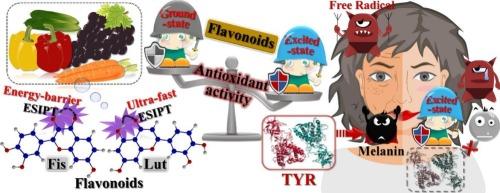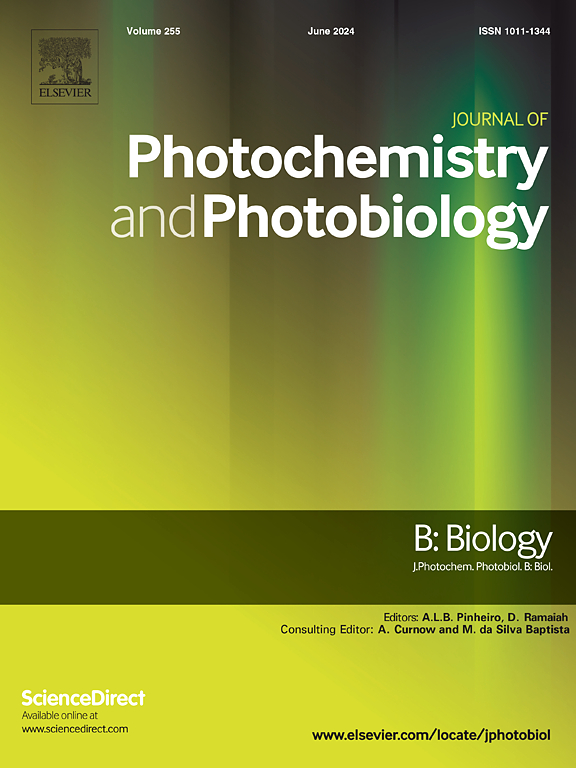揭示esipt类黄酮的抗氧化和酪氨酸酶抑制活性:DFT/TD-DFT计算和分子对接
IF 3.7
2区 生物学
Q2 BIOCHEMISTRY & MOLECULAR BIOLOGY
Journal of photochemistry and photobiology. B, Biology
Pub Date : 2025-05-29
DOI:10.1016/j.jphotobiol.2025.113190
引用次数: 0
摘要
利用量子化学方法和分子对接,研究了激发态黄酮类化合物(非瑟酮和木犀草素)具有激发态分子内质子转移过程(ESIPT)性质的抗氧化和酪氨酸酶抑制活性。结合过渡态理论,热力学参数计算表明,非塞酮和木草素分别通过氢原子抽离(HAA)和单电子转移(SET)机制清除过氧化氢自由基(HOO),其中基于HAA机制的反应能垒和反应速率表明,b环上的酚羟基比a环上的酚羟基更容易受到HOO的攻击。势能曲线分别显示了非塞酮和木犀草素的能量势垒和超快ESIPT过程,从而确定了激发态结构。进一步,利用分子前沿轨道和平均局域电离能对激发态分子的抗氧化活性进行了研究,发现在光激发下活性显著增强,尤其是在ESIPT过程后形成的酮类化合物。此外,分子对接表明黄酮类化合物实现了酪氨酸酶的抑制。ESIPT过程与激发态黄酮类化合物生物活性之间的关系不仅为天然抗氧化活性分子的设计提供了理论依据,而且为基于光活化机制开发抗衰老药物开辟了新的途径。本文章由计算机程序翻译,如有差异,请以英文原文为准。

Unveiling antioxidant and tyrosinase inhibitory activities of ESIPT-based flavonoids: DFT/TD-DFT calculations and molecular docking
The antioxidant and tyrosinase inhibitory activities of excited-state flavonoids (fisetin and luteolin) with excited state intramolecular proton transfer process (ESIPT) property have been explored by quantum chemical methods and molecular docking. Combined with transition-state theory, the thermodynamic parameter calculations indicate that fisetin and luteolin scavenge hydrogen peroxide radical (HOO![]() ) through hydrogen atom abstraction (HAA) and single electron transfer (SET) mechanisms, respectively, where the reaction energy barriers and rates based on the HAA mechanism are shown to indicate phenolic hydroxyl groups on the B-ring are more susceptible to HOO
) through hydrogen atom abstraction (HAA) and single electron transfer (SET) mechanisms, respectively, where the reaction energy barriers and rates based on the HAA mechanism are shown to indicate phenolic hydroxyl groups on the B-ring are more susceptible to HOO![]() attack than that on the A-ring. Potential energy curves show energy-barrier and ultrafast ESIPT processes for fisetin and luteolin, respectively, thus determining excited-state structures. Further, utilizing frontier molecular orbitals and averaged local ionization energy, the antioxidant activity of excited state molecules is explored, which reveals that the activity is significantly boosted upon photoexcitation, especially the keto⁎ form formed after ESIPT process. Additionally, the molecular docking indicates that the flavonoids achieve inhibition of tyrosinase. The relationship between the ESIPT process and bioactivity of excited-state flavonoids not only provides a theoretical basis for the design of natural antioxidant-active molecules, but also develops a novel pathway for the exploitation of anti-aging agents based on photoactivation mechanisms.
attack than that on the A-ring. Potential energy curves show energy-barrier and ultrafast ESIPT processes for fisetin and luteolin, respectively, thus determining excited-state structures. Further, utilizing frontier molecular orbitals and averaged local ionization energy, the antioxidant activity of excited state molecules is explored, which reveals that the activity is significantly boosted upon photoexcitation, especially the keto⁎ form formed after ESIPT process. Additionally, the molecular docking indicates that the flavonoids achieve inhibition of tyrosinase. The relationship between the ESIPT process and bioactivity of excited-state flavonoids not only provides a theoretical basis for the design of natural antioxidant-active molecules, but also develops a novel pathway for the exploitation of anti-aging agents based on photoactivation mechanisms.
求助全文
通过发布文献求助,成功后即可免费获取论文全文。
去求助
来源期刊
CiteScore
12.10
自引率
1.90%
发文量
161
审稿时长
37 days
期刊介绍:
The Journal of Photochemistry and Photobiology B: Biology provides a forum for the publication of papers relating to the various aspects of photobiology, as well as a means for communication in this multidisciplinary field.
The scope includes:
- Bioluminescence
- Chronobiology
- DNA repair
- Environmental photobiology
- Nanotechnology in photobiology
- Photocarcinogenesis
- Photochemistry of biomolecules
- Photodynamic therapy
- Photomedicine
- Photomorphogenesis
- Photomovement
- Photoreception
- Photosensitization
- Photosynthesis
- Phototechnology
- Spectroscopy of biological systems
- UV and visible radiation effects and vision.

 求助内容:
求助内容: 应助结果提醒方式:
应助结果提醒方式:


